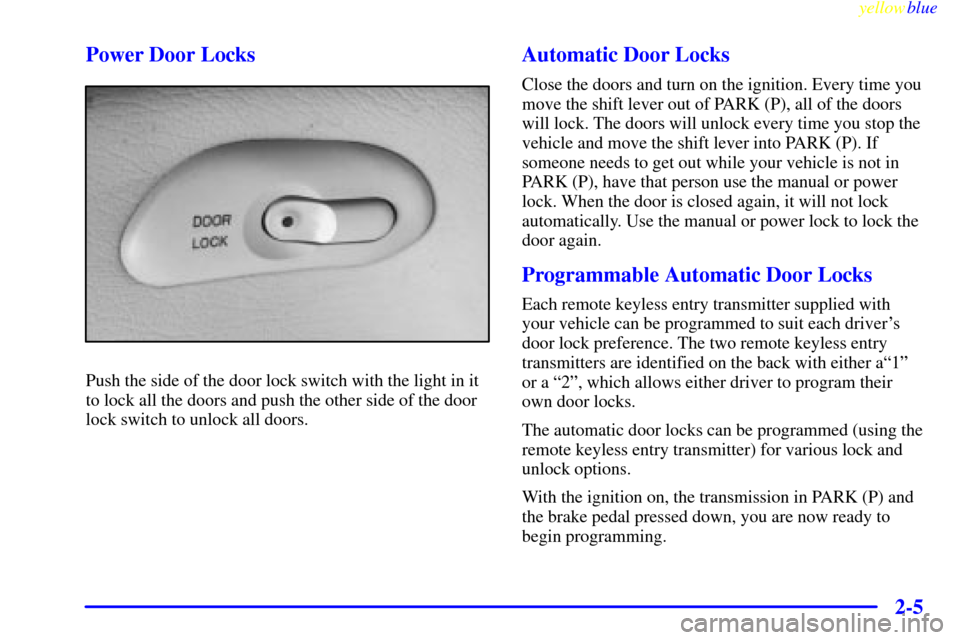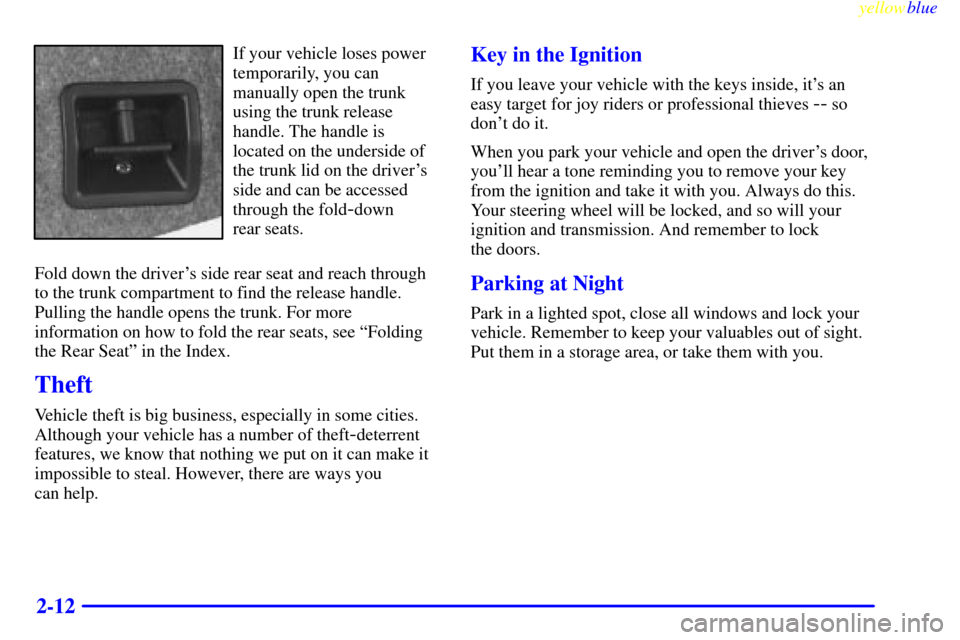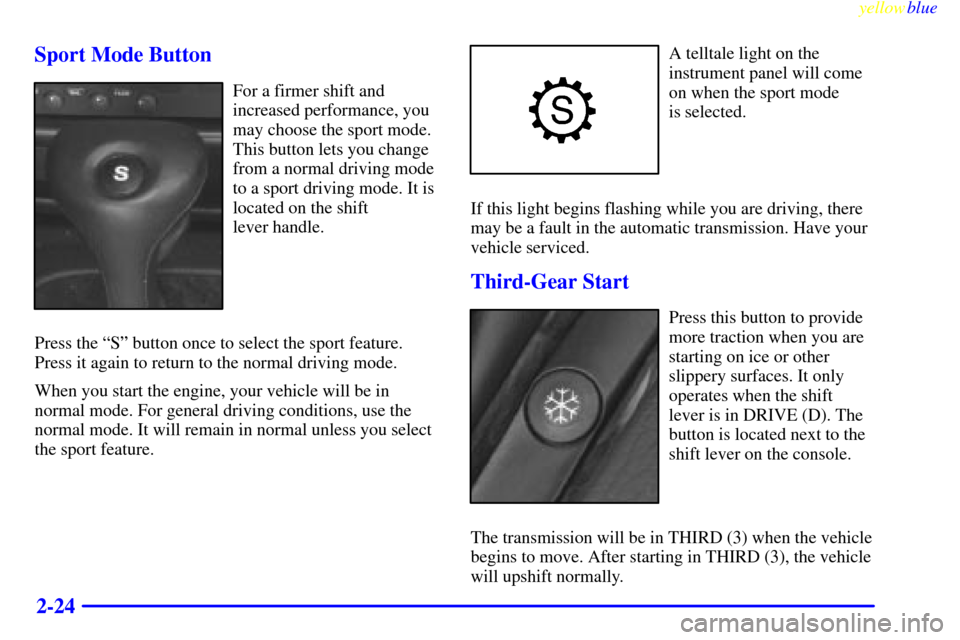Page 63 of 328

2-
yellowblue
2-1
Section 2 Features and Controls
Here you can learn about the many standard and optional features on your vehicle, and information on starting,
shifting and braking. Also explained are the instrument panel and the warning systems that tell you if everything is
working properly
-- and what to do if you have a problem.
2
-2 Keys
2
-4 Door Locks
2
-7 Remote Keyless Entry System (RKE)
2
-11 Trunk
2
-12 Theft
2
-13 Theft-Deterrent System
2
-15 Immobilizer
2
-16 New VehicleªBreak-Inº
2
-16 Ignition Positions
2
-18 Starting Your Engine
2
-19 Engine Coolant Heater (If Equipped)
2
-21 Automatic Transmission Operation
2
-25 Parking Brake
2
-26 Shifting Into PARK (P)
2
-28 Shifting Out of PARK (P)2
-30 Parking Over Things that Burn
2
-30 Engine Exhaust
2
-31 Running Your Engine While You're Parked
2
-32 Windows
2
-33 Horn
2
-34 Tilt Wheel
2
-34 Turn Signal/Multifunction Lever
2
-40 Exterior Lamps
2
-46 Interior Lamps
2
-47 Mirrors
2
-49 Storage Compartments
2
-52 Sunroof (Option)
2
-56 Universal Transmitter (If Equipped)
2
-60 Instrument Panel
2
-63 Warning Lights, Gages and Indicators
Page 67 of 328

yellowblue
2-5 Power Door Locks
Push the side of the door lock switch with the light in it
to lock all the doors and push the other side of the door
lock switch to unlock all doors.
Automatic Door Locks
Close the doors and turn on the ignition. Every time you
move the shift lever out of PARK (P), all of the doors
will lock. The doors will unlock every time you stop the
vehicle and move the shift lever into PARK (P). If
someone needs to get out while your vehicle is not in
PARK (P), have that person use the manual or power
lock. When the door is closed again, it will not lock
automatically. Use the manual or power lock to lock the
door again.
Programmable Automatic Door Locks
Each remote keyless entry transmitter supplied with
your vehicle can be programmed to suit each driver's
door lock preference. The two remote keyless entry
transmitters are identified on the back with either aª1º
or a ª2º, which allows either driver to program their
own door locks.
The automatic door locks can be programmed (using the
remote keyless entry transmitter) for various lock and
unlock options.
With the ignition on, the transmission in PARK (P) and
the brake pedal pressed down, you are now ready to
begin programming.
Page 74 of 328

yellowblue
2-12
If your vehicle loses power
temporarily, you can
manually open the trunk
using the trunk release
handle. The handle is
located on the underside of
the trunk lid on the driver's
side and can be accessed
through the fold
-down
rear seats.
Fold down the driver's side rear seat and reach through
to the trunk compartment to find the release handle.
Pulling the handle opens the trunk. For more
information on how to fold the rear seats, see ªFolding
the Rear Seatº in the Index.
Theft
Vehicle theft is big business, especially in some cities.
Although your vehicle has a number of theft
-deterrent
features, we know that nothing we put on it can make it
impossible to steal. However, there are ways you
can help.
Key in the Ignition
If you leave your vehicle with the keys inside, it's an
easy target for joy riders or professional thieves
-- so
don't do it.
When you park your vehicle and open the driver's door,
you'll hear a tone reminding you to remove your key
from the ignition and take it with you. Always do this.
Your steering wheel will be locked, and so will your
ignition and transmission. And remember to lock
the doors.
Parking at Night
Park in a lighted spot, close all windows and lock your
vehicle. Remember to keep your valuables out of sight.
Put them in a storage area, or take them with you.
Page 75 of 328

yellowblue
2-13 Parking Lots
If you park in a lot where someone will be watching
your vehicle, it's best to lock it up and take your keys.
But what if you have to leave your key?
�If possible, park in a busy, well lit area.
�Put your valuables in a storage area, like your
trunk or glove box. Be sure to close and lock the
storage area.
�Close all windows.
�Move the trunk release lockout switch to LK (lock).
�Lock the glove box.
�Lock all the doors except the driver's.
�Then take the door key and remote keyless entry
transmitter with you.
Theft-Deterrent System
If the ignition is off
and any door is open, the
SECURITY light will flash
to remind you to activate
the system.
1. Open the door.
2. Lock the door using the power door lock or the
remote keyless entry transmitter. The SECURITY
light should come on and stay on.
3. Close all the doors. The SECURITY light should go
off within approximately 30 seconds.
The horn will sound and the headlamps will flash for
several minutes when the door or trunk is opened
without the key or remote keyless entry transmitter.
The horn also sounds if the locks are damaged.
Remember, the theft
-deterrent system won't activate if
you lock the doors with a key or use the manual door
lock. It activates only if you use a power door lock
switch or the remote keyless entry transmitter.
Page 76 of 328

yellowblue
2-14
To avoid activating the alarm by accident:
�The vehicle should be locked with the key after the
doors are closed if you don't want to activate the
theft
-deterrent system.
�Always unlock a door with a key or use the remote
keyless entry transmitter. (Pressing the unlock button
on the remote keyless entry transmitter disables the
theft
-deterrent system.) Unlocking a door any other
way will activate the alarm. Cycling the ignition
without disarming the theft
-deterrent system will
also activate the alarm.
If you activate the alarm by accident, unlock the driver's
door with your key. You can also turn off the alarm by
using the remote keyless entry transmitter. The alarm
won't stop if you try to unlock a door in any other way.
Testing the Alarm
1. From inside the vehicle, roll down the window, then
get out of the vehicle, keeping the door open.
2. From outside the vehicle, with the door open, lock
the vehicle using the power door lock or the remote
keyless entry transmitter and close the door. Wait
30 seconds until the SECURITY light stops flashing.
3. Reach in and unlock the door using the manual lock
and open the door. The horn will sound and the
headlamps will flash.
If the alarm does not sound when it should, check to see
if the horn works. The horn fuse may be blown. To
replace the fuse, see ªFuses and Circuit Breakersº in the
Index. If the fuse does not need to be replaced, you may
need to have your vehicle serviced.
To reduce the possibility of theft, always activate the
optional theft
-deterrent system when leaving
your vehicle.
Page 86 of 328

yellowblue
2-24 Sport Mode Button
For a firmer shift and
increased performance, you
may choose the sport mode.
This button lets you change
from a normal driving mode
to a sport driving mode. It is
located on the shift
lever handle.
Press the ªSº button once to select the sport feature.
Press it again to return to the normal driving mode.
When you start the engine, your vehicle will be in
normal mode. For general driving conditions, use the
normal mode. It will remain in normal unless you select
the sport feature.
A telltale light on the
instrument panel will come
on when the sport mode
is selected.
If this light begins flashing while you are driving, there
may be a fault in the automatic transmission. Have your
vehicle serviced.
Third-Gear Start
Press this button to provide
more traction when you are
starting on ice or other
slippery surfaces. It only
operates when the shift
lever is in DRIVE (D). The
button is located next to the
shift lever on the console.
The transmission will be in THIRD (3) when the vehicle
begins to move. After starting in THIRD (3), the vehicle
will upshift normally.
Page 87 of 328
yellowblue
2-25
This feature is for improved traction only when the road
surface is slippery and is not intended for continuous use
or when the vehicle is stuck in sand, mud, ice, snow or
gravel. Drive as usual for normal road conditions.
This feature automatically turns off when any of the
following conditions occur:
�When the ignition is turned off.
�If the shift lever is placed in PARK (P), THIRD (3),
SECOND (2), or FIRST (1).
�If you press and hold the accelerator pedal past its
resistance point for more than two seconds.
�When speed falls below 25 mph (40 km/h).
�Once the vehicle reaches 67 mph (108 km/h).
To turn this feature off, press the button again.
Whenever you start your vehicle, the transmission is in
the normal mode.Parking Brake
To set the parking brake, hold the regular brake pedal
down with your foot and pull up on the parking brake
lever. If the ignition is on, the brake system warning
light will come on.
Page 88 of 328

yellowblue
2-26
If you start to drive with the parking brake set, the
BRAKE warning light stays on. See ªBrake System
Warning Lightº in the Index for more information.
To release the parking brake, hold the brake pedal down
with your foot and pull the parking brake lever up until
you can press the end release button. Hold the release
button in as you move the brake lever all the way down.
NOTICE:
Driving with the parking brake on can cause the
rear brakes to overheat. You may have to replace
them, and you could also damage other parts of
your vehicle.
If you are towing a trailer and are parking on a hill, see
ªTowing a Trailerº in the Index. This section shows
what to do first to keep the trailer from moving.
Shifting Into PARK (P)
CAUTION:
It can be dangerous to get out of your vehicle if
the shift lever is not fully in PARK (P) with the
parking brake firmly set. Your vehicle can roll. If
you have left the engine running, the vehicle can
move suddenly. You or others could be injured.
To be sure your vehicle won't move, even when
you're on fairly level ground, use the steps that
follow. If you're pulling a trailer, see ªTowing a
Trailerº in the Index.